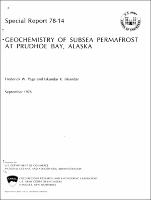Please use this identifier to cite or link to this item:
https://hdl.handle.net/11681/11738| Title: | Geochemistry of subsea permafrost at Prudhoe Bay, Alaska |
| Authors: | United States. Department of Commerce United States. National Oceanic and Atmospheric Administration Page, Frederick W. Iskandar, I. K. (Iskandar Karam), 1938- |
| Keywords: | Chemical analyses Chemical analysis Chemical composition Chemistry Permafrost Prudhoe Bay, Alaska Subsea permafrost Sediments Sea water Drilling Drill core analysis |
| Publisher: | Cold Regions Research and Engineering Laboratory (U.S.) Engineer Research and Development Center (U.S.) |
| Series/Report no.: | Special report (Cold Regions Research and Engineering Laboratory (U.S.)) ; 78-14. |
| Description: | Special Report Abstract: The analytical data from sediment, interstitial water, and seawater analyses of samples collected near Prudhoe Bay, Alaska, during the period from March to May 1977, are presented. Analyses include determinations of moisture, calcium carbonate, and organic carbon contents in the sediment samples and pH, electrical conductivity, alkalinity, and concentrations of sodium, potassium, calcium, magnesium, chloride, and sulfate in the interstitial water and seawater samples. Salinity, ionic balance, and freezing point of the water samples were calculated. The marine sediments in Prudhoe Bay generally, contain more calcium carbonate, organic carbon, and interstitial water than the underlying glacial and fluvial gravels. On land, a surficial layer of peat also had high organic carbon and moisture contents. The salinity of the seawater samples varied from concentrated brines near the shore where sea ice is frozen directly to, or is located near, the sea bottom to water which was 1.0 to 1.5 ppct.less saline than normal seawater at a distance of approximately 10 to 15 km from shore. Potassium, calcium, sulfate, and alkalinity concentrations all showed significant variations from those of normal seawater. The interstitial water samples from sediments taken from the marine boreholes generallycontained water whose overall composition was close to that for normal seawater, suggesting that seawater had either infiltrated into, or had been deposited with, the sediments. Potassium, calcium, alkalinity, sulfate, and magnesium' concentrations showed significant variations from those of normal seawater. These variations are thought to be a result of various chemical and biological reactions such as the oxidation of organic matter, ion exchange, weathering of potassium-rich minerals, reduction of sulfate, and the dissolution, precipitation, and/or recrystallization of calcium and/or calcium-magnesium carbonates. On land, the salinity of the interstitial water increased with depth as the composition became progressively more like that of normal seawater. Calculated freezing points, when used in conjunction with temperature data obtainable from the U.S. Geological Survey, indicate that ice-bonded permafrost was encountered at depths of 30.5 and 62 m below the ice surface at distances of 1.0 and 3.2 km from land, respectively. Bonded sediments were also found in the surficial peats on land. In addition, partially frozen sediments were found in sediments located near the sediment/water interface. This zone passed laterally into more bonded sediments closer to shore. |
| Rights: | Approved for public release; distribution is unlimited. |
| URI: | http://hdl.handle.net/11681/11738 |
| Appears in Collections: | Special Report |
Files in This Item:
| File | Description | Size | Format | |
|---|---|---|---|---|
| SR-78-14.pdf | 3.09 MB | Adobe PDF |  View/Open |